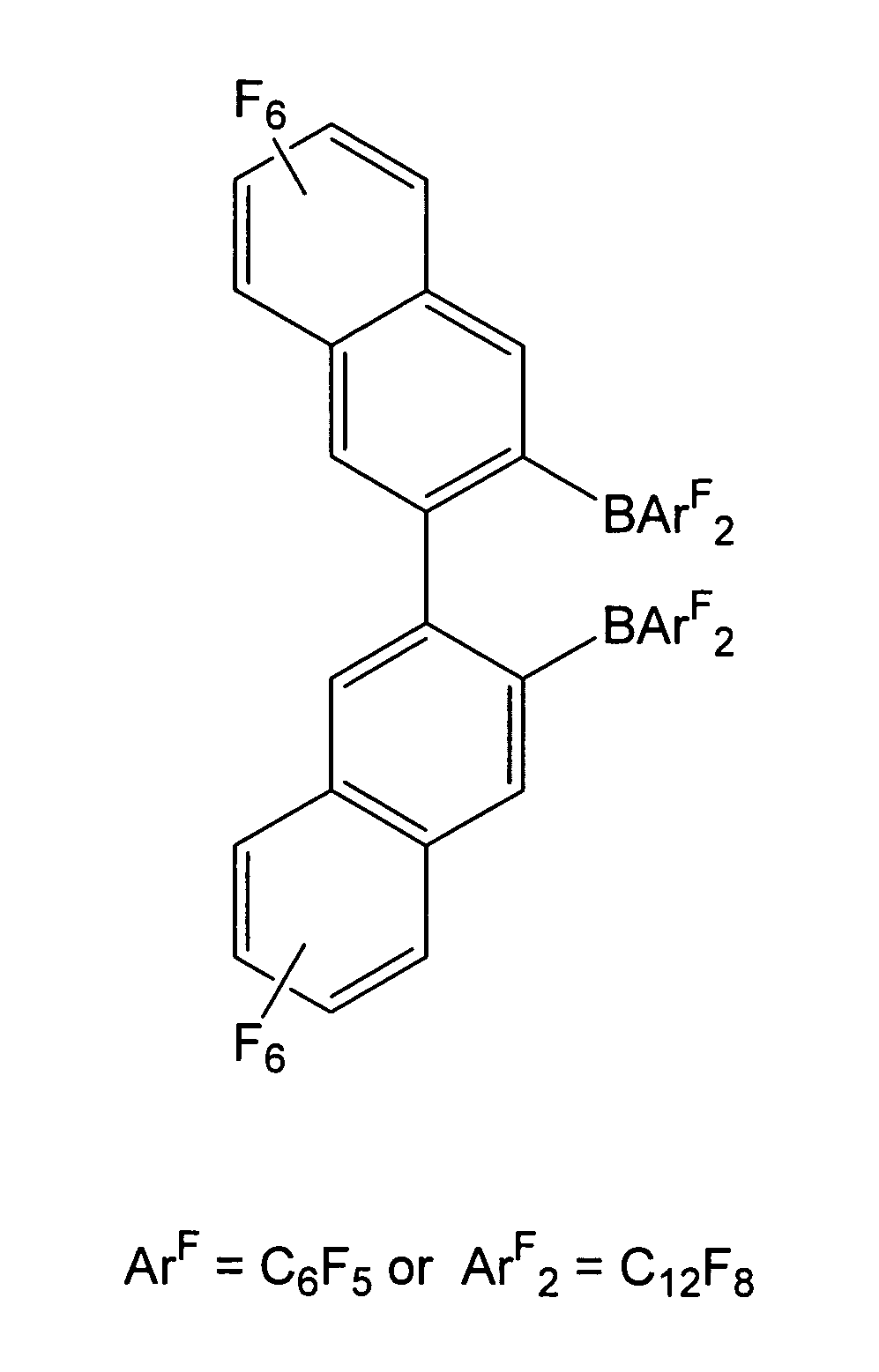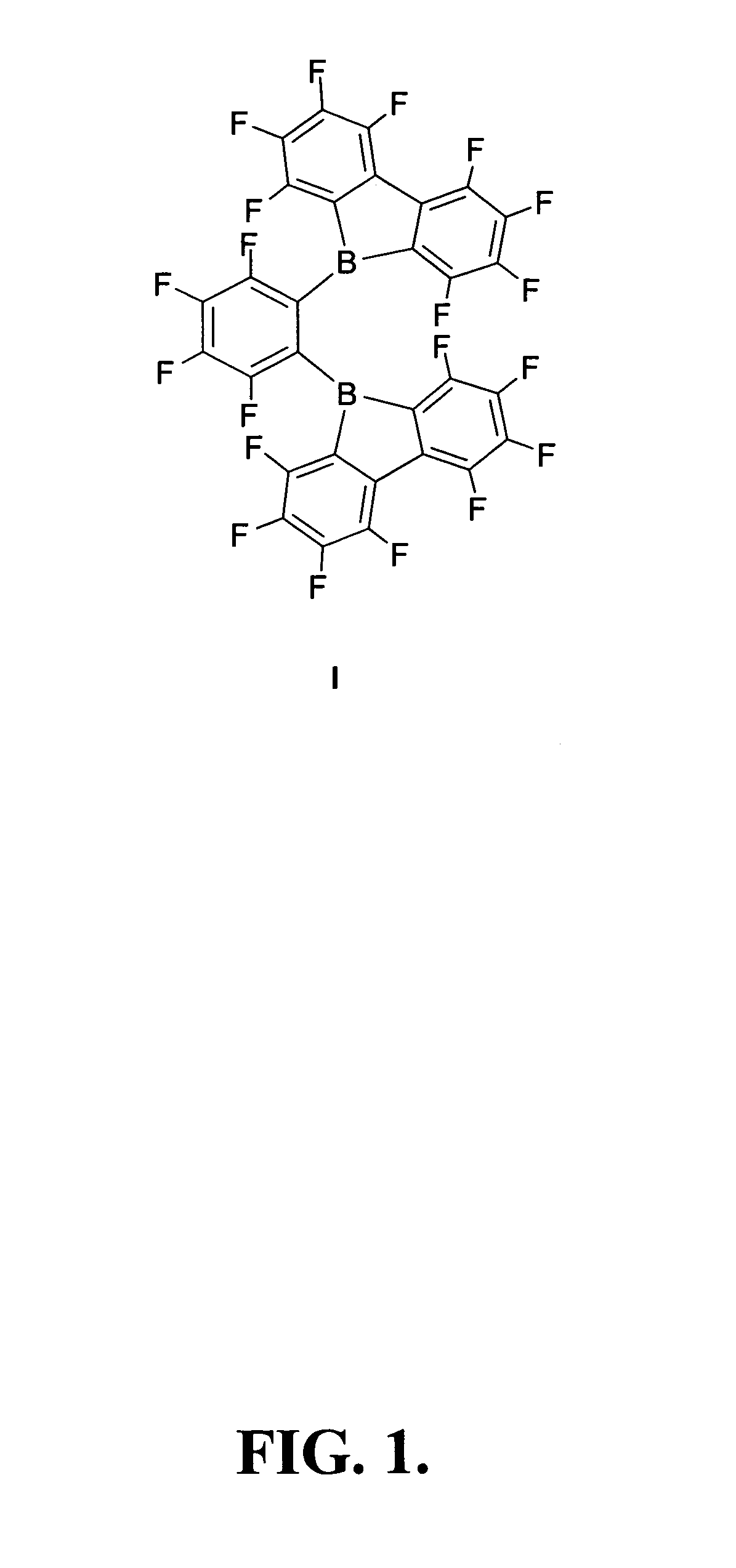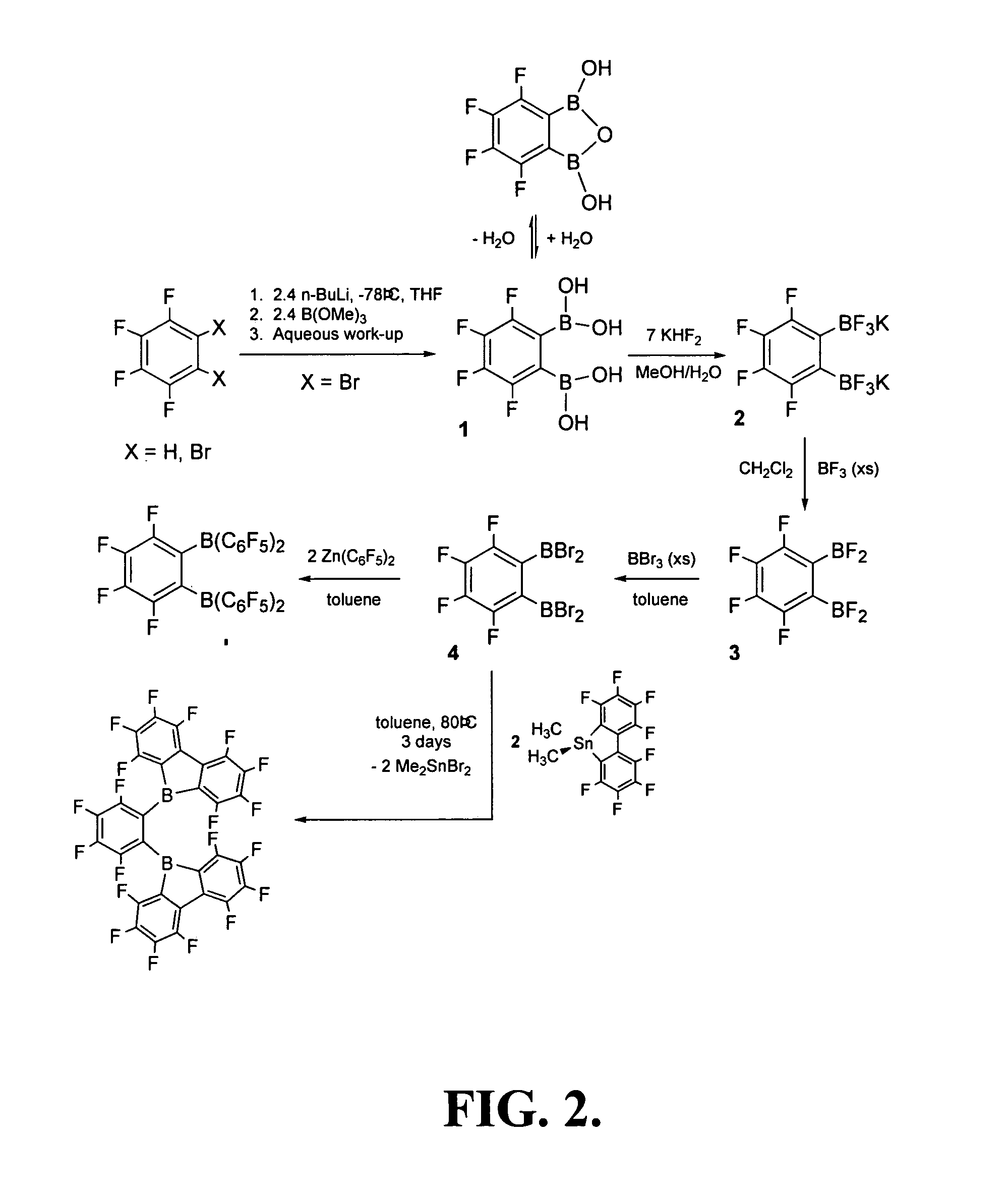1,2-bis(9-bora-1,2,3,4,5,6,7,8-octafluorofluorenyl)-3,4,5,6-tetraflurobenzene and related compounds and methods
a technology of tetrafluorene and tetrafluorene, which is applied in the field of compound 1, 2bis (9bora1, 2, 3, 4, 5, 6, 7, 8octafluorenyl)3, 4, 5, 6tetraflurobenzene, can solve the problem that none of these compositions actually provides butyl rubber of sufficiently high molecular weight at acceptable levels
- Summary
- Abstract
- Description
- Claims
- Application Information
AI Technical Summary
Benefits of technology
Problems solved by technology
Method used
Image
Examples
example 1
Synthesis of 1,2-bis(9-Bora-1,2,3,4,5,6,7,8-octafluorofluorenyl)-3,4,5,6-tetrafluorobenzene: 1,2-[B(C12F8)]2C6F4
[0061]General Considerations. NMR spectra were measured on a Bruker Avance DRX-400 (11B at 128.41 MHz) and a Bruker AMX2-300 (19F at 282.41 MHz). 11B NMR spectra were referenced relative to BF3.Et2O at 0 ppm. 19F NMR spectra were referenced externally to C6F6 at −163 ppm relative to CFCl3 at 0 ppm. 1,2-Dibromotetrafluorobenzene (Aldrich), 1.6 M BuLi (Aldrich), KHF2 (Aldrich), and BF3 (Aldrich) were used as supplied. B(OCH3)3 (Aldrich) was distilled over Na prior to use and BBr3 (Aldrich) was distilled from Cu wire prior to use.
[0062]All manipulations with aryldihalogenboranes were performed using standard vacuum and Schlenk techniques or in a glovebox under an atmosphere of argon. CH2Cl2 was distilled from CaH2 prior to use. CD2Cl2 and C6D6 were purchased from Cambridge Isotopes and rigorously dried then distilled from CaH2 and Na / benzophenone respectively. CD3CN and D2O ...
example 2
Synthesis of 1,2-bis[Di(perfluorophenyl)borvl]-3,4,5,6-tetrafluorobenzene: 1,2-[B(C6F5)2]2C6F4
[0069]The synthesis of 1,2-bis[di(perfluorophenyl)boryl]-3,4,5,6-tetrafluorobenzene (1,2-[B(C6F5)2]2C6F4) (Compound II) described below is schematically illustrated in FIG. 2.
[0070]Compound II was prepared from 1,2-bis(dibromoboryl)tetrafluorobenzene (4), prepared as described above in Example 1.
[0071]Toluene (25 ml) was condensed into an evacuated bomb containing Zn(C6F5)2 (1.40 g, 3.50 mmol) at −78° C. To this colorless solution was added boran 1,2-bis-(dibromoboryl)tetrafluorobenzene (0.84 g, 1.73 mmol) as a neat liquid. The mixture was heated at 80° C. for 12 hours, after which the toluene was removed under reduced pressure. The white residue was extracted using toluene (40 ml), filtered and concentrated. The product was isolated after crystallization from hot toluene and washing with cold hexanes (0.8 g, 0.95 mmol, 55%). 19F NMR (C6D6) δ−127.6 (m, 2F, C6F4); −128.5 (d, 8F, o-C6F5); −1...
example 3
Polymerization of Ethylene with Zirconocene / 9-Borafluorene Catalyst Systems
[0072]This example describes the use of 9-borafluorene Lewis acids as co-catalysts in the realm of metallocene catalyzed olefin polymerization. The bifunctional 9-borafluorene was found to react with only one equivalent of zirconocene methyl but the additional Lewis acidic group may be involved in lowering the barrier to exchange via a boron / methyl interaction in the exchange transition state. The chelated ring structure of the 9-borafluorene Lewis acids has been exploited in the stabilization of the produced ion pairs by preventing fluoroaryl ring transfer as a catalyst deactivation mechanism. The complex produced with the methyl substituted 9-borafluorene 5 undergoes methane elimination at elevated temperatures to produce a μ-methylene bridged zirconium species, Cp2Zr(Me)—CH2—B(Me)(C12F8). The 9-borafluorenes were evaluated as co-catalysts for ethylene polymerization and found to be comparable to analogous ...
PUM
| Property | Measurement | Unit |
|---|---|---|
| temperatures | aaaaa | aaaaa |
| temperature | aaaaa | aaaaa |
| pH | aaaaa | aaaaa |
Abstract
Description
Claims
Application Information
 Login to View More
Login to View More - R&D
- Intellectual Property
- Life Sciences
- Materials
- Tech Scout
- Unparalleled Data Quality
- Higher Quality Content
- 60% Fewer Hallucinations
Browse by: Latest US Patents, China's latest patents, Technical Efficacy Thesaurus, Application Domain, Technology Topic, Popular Technical Reports.
© 2025 PatSnap. All rights reserved.Legal|Privacy policy|Modern Slavery Act Transparency Statement|Sitemap|About US| Contact US: help@patsnap.com



